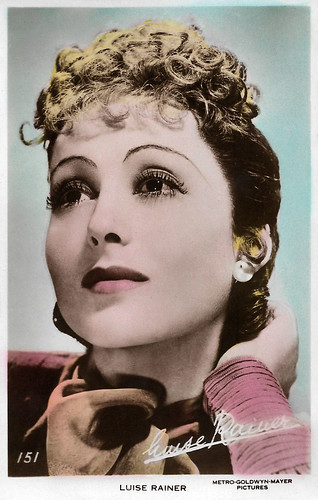
British postcard by Art Photo, no. 151. Photo: Metro-Goldwyn-Mayer Pictures.
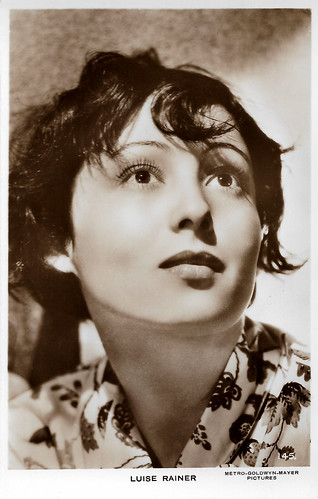
British Real Photograph postcard, no. 145. Photo: MGM (Metro-Goldwyn-Mayer).
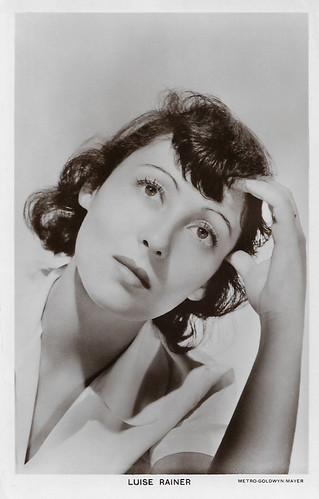
British postcard in the Picturegoer Series, London, no. 1048b. Photo: Metro Goldwyn Mayer.
An unusual talent for a young actress
Luise Rainer was born in 1910 in Düsseldorf, in then the German Empire (now Germany). Her parents were Heinrich and Emilie (née Königsberger) Rainer. Her father was a businessman who settled in Europe after spending most of his childhood in Texas.
Rainer's rebellious nature made her appear to be a "tomboy" and happy to be alone. She started her acting career in Berlin at age 16, under the pretext of visiting her mother, she traveled to Düsseldorf for a prearranged audition at the Dumont Theater.
In the 1920s the theatre director Louise Dumont separated from her husband. Dumont was attached to a number of young actresses including Fita Benkhoff, Hanni Hoessrich, and Rainer. It has been presumed that Dumont was bisexual.
Rainer later began studying acting with the leading stage director at the time, Max Reinhardt. By the time she was 18, several critics felt that she had an unusual talent for a young actress. She became a distinguished Berlin stage actress with Reinhardt's theatre ensemble.
She also appeared in several German-language films. After years of acting on stage and in films in Austria and Germany, she was discovered by MGM talent scout Phil Berg, who signed her to a three-year contract in Hollywood in 1935. He thought she would appeal to the same audience as Swedish MGM star Greta Garbo. Mayer assigned actress Constance Collier to train her in speech and dramatic modulation, and Rainer's English improved rapidly.

German postcard by Ross Verlag, no. 7766/1, 1932-1933. Photo: Boston-Film. Hans Albers and Luise Rainer in Heut' kommt's drauf an/Today it depends (Kurt Gerron, 1933). This film, now considered lost, was the second film with Luise Rainer.
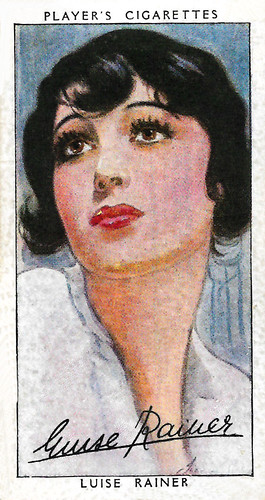
Small, British collectors card in the Film Stars series by Player's Cigarettes (John Player & Sons), Third Series, no. 39. Illustration: Metro-Goldwyn-Mayer.

Belgian card by Kwatta in the Ciné Stars series. Photo: M.G.M. Fernand Gravey and Luise Rainer in The Great Waltz (Julien Duvivier, 1938).
Hollywood's next sensation
Luise Rainer's first American film role was in the romantic comedy Escapade (Robert Z. Leonard, 1935) with William Powell. It is a remake of the popular Austrian Operetta film Maskerade/Masquerade (Willy Forst, 1934).
The film generated immense publicity for Rainer, who was hailed as "Hollywood's next sensation". The following year she was given a supporting part as the real-life character Anna Held in the musical biography The Great Ziegfeld (Robert Z. Leonard, 1936), featuring William Powell.
Despite her limited role, her emotion-filled performance so impressed audiences that she was awarded the Oscar for Best Actress. She was later dubbed the "Viennese Teardrop" for her dramatic telephone scene, attempting to congratulate Ziegfeld on his new marriage, in the film.
On the evening of the Academy Award ceremonies, Rainer remained at home, not expecting to win. When Mayer learned she had won, he sent MGM publicity head Howard Strickling racing to her home to get her. She was also awarded the New York Film Critics' Award for the performance.
For her next role, producer Irving Thalberg was convinced, despite the studio's disagreement, that she would also be able to play the part of a poor, plain Chinese farm wife opposite Paul Muni in The Good Earth (Sidney Franklin, 1937), based on Nobel Prize-winning author Pearl Buck's novel about hardship in China.
The humble, subservient, and mostly silent character role was such a dramatic contrast to her previous vivacious character that she again won the Oscar for Best Actress. Rainer and Jodie Foster are the only actresses ever to win two Oscars by the age of thirty.

French postcard by EPC, no. 225. Photo: MGM (Metro-Goldwyn-Mayer).
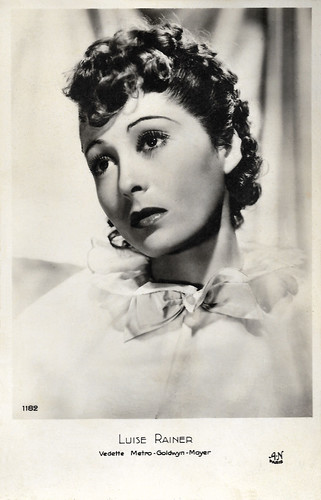
French postcard by A.N., Paris, no. 1182. Photo: Metro Goldwyn Mayer.
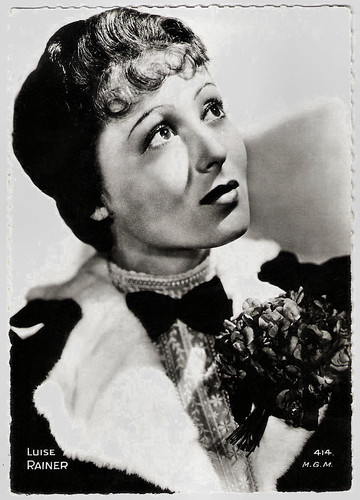
French postcard by Collection Chantal, Paris, no. 414. Photo: M.G.M. Luise Rainer in her Oscar-winning role as Anna Held in The Great Ziegfeld (Robert Z. Leonard, 1936).
The most extreme case of an Oscar victim in Hollywood mythology
However, Luise Rainer later stated nothing worse could have happened to her than winning two consecutive Oscars, as audience expectations from then on would be too high to fulfill. A few months before the film was completed, Irving Thalberg died suddenly at the age of 37. Rainer commented years later: "His death was a terrible shock to us. He was young and ever so able. Had it not been that he died, I think I may have stayed much longer in films."
After four more, insignificant roles, MGM and Rainer became disappointed, and she was dubbed "Box Office Poison" by the Independent Theatre Owners of America. Adding to her rapid decline, some feel, was the poor career advice she received from her then-husband, playwright Clifford Odets. She ended her brief three-year Hollywood career and returned to Europe where she helped get aid to children who were victims of the Spanish Civil War.
Nevertheless, she was not released from her MGM contract and, by 1940, she was still bound to make one more film for the studio. Some film historians consider her the "most extreme case of an Oscar victim in Hollywood mythology". Rainer studied medicine and returned to the stage. In 1939, she made her first appearance at the Palace Theatre, Manchester in Jacques Deval's play 'Behold the Bride', and later played the same part in her London debut at the Shaftesbury Theatre.
Returning to America, she played the leading part in George Bernard Shaw's 'Saint Joan' in 1940 at the Belasco Theatre in Washington, D.C. under the direction of German emigrant director Erwin Piscator. In 1943, she made an appearance in the film Hostages (Frank Tuttle, 1943).
Rainer abandoned film making in 1944 after marrying publisher Robert Knittel. She made sporadic television and stage appearances, appearing in an episode of the World War II television series Combat! in 1965. She took a dual role in a 1984 episode of The Love Boat.
In 1997, she appeared in the film The Gambler (Károly Makk, 1997), starring Michael Gambon. It marked her film comeback at the age of 86.
Luise Rainer passed away in 2014, in Belgravia, London, England. She was 104. Rainer married Clifford Odets in 1937 and they divorced in 1940. Her second husband was publisher Robert Knittel. They were married from 1945 till his death in 1989 and lived in the UK and Switzerland for most of their marriage. The couple had one daughter, Francesca Knittel.

Italian postcard by Rizzoli & C. Milano, 1938. Photo: Metro-Goldwyn-Mayer.
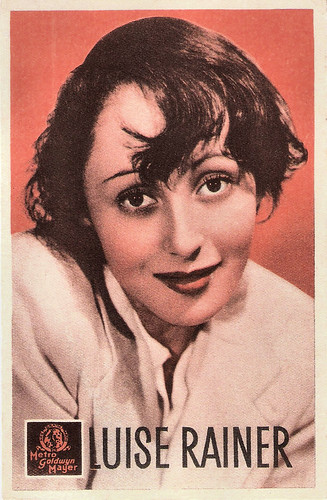
Vintage postcard. Photo: Metro Goldwyn Mayer.
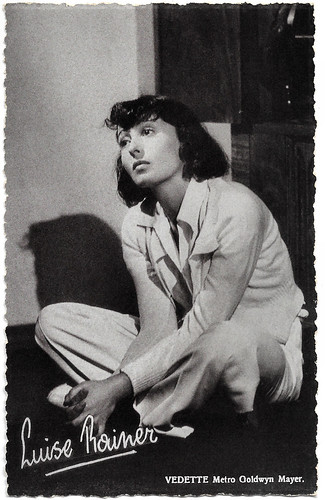
Belgian postcard by Kwatta / Nels Bromurite, no. 1182. Photo: Metro Goldwyn Mayer.
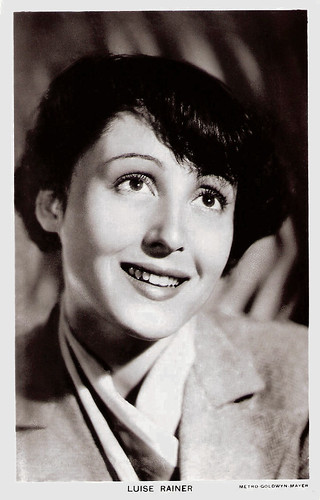
British postcard in the Picturegoer Series, London, no. 1048. Photo: Metro Goldwyn Mayer.
Sources: Wikipedia and IMDb.
No comments:
Post a Comment